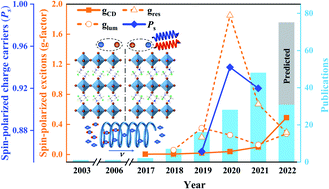Spin-polarized excitons and charge carriers in chiral metal halide semiconductors
Abstract
Chirality is one of the fundamental phenomena existing in nature and widely applied in many fields such as asymmetric catalysis, optoelectronic devices, biomedicine, information communication, and so on. As an emerging semiconducting material, organic–inorganic hybrid metal halides have the advantages of a high absorption coefficient, long charge diffusion length, high defect tolerance, and easy preparation. The structural and compositional diversity of metal halide semiconductors makes it possible to introduce chirality and create a new class of chiral materials that exhibit different properties from other conventional ones. Recently, chiral metal halides have attracted extensive attention mainly by incorporating chiral organic molecules into metal halide lattices. Thanks to inversion-symmetry breaking and enhanced spin–orbit coupling (SOC), excitons and charge carriers in chiral metal halides exhibit a strong spin-polarization response. Here, we summarized the chiral effects on exciton and charge behaviours in metal halide semiconductors, followed by their unique optical and electrical properties, and finally presented their (opto-)electronic applications, such as in circular-polarization photodetectors, spin-LEDs and spin valves.

- This article is part of the themed collection: Journal of Materials Chemistry A Emerging Investigators


 Please wait while we load your content...
Please wait while we load your content...